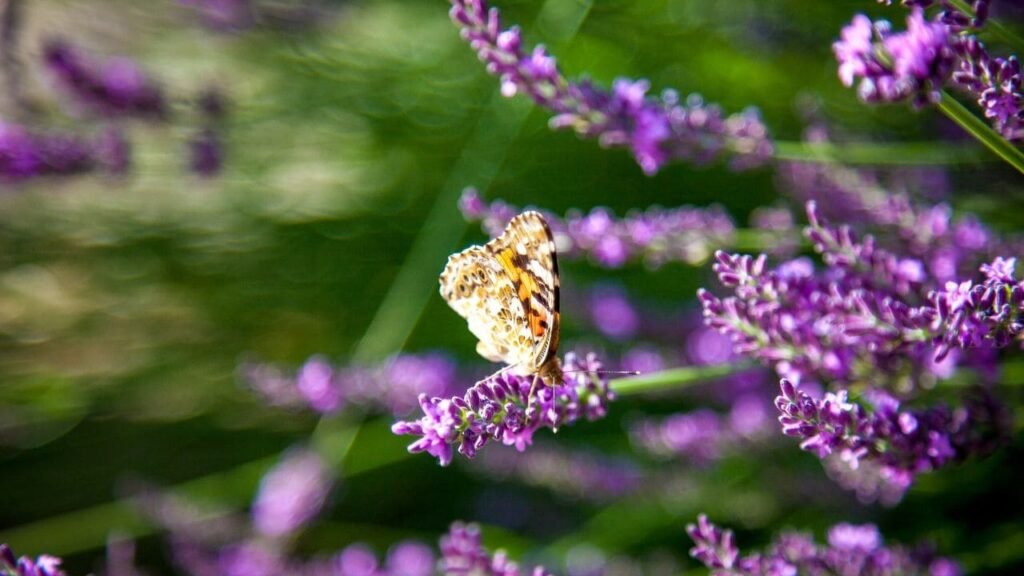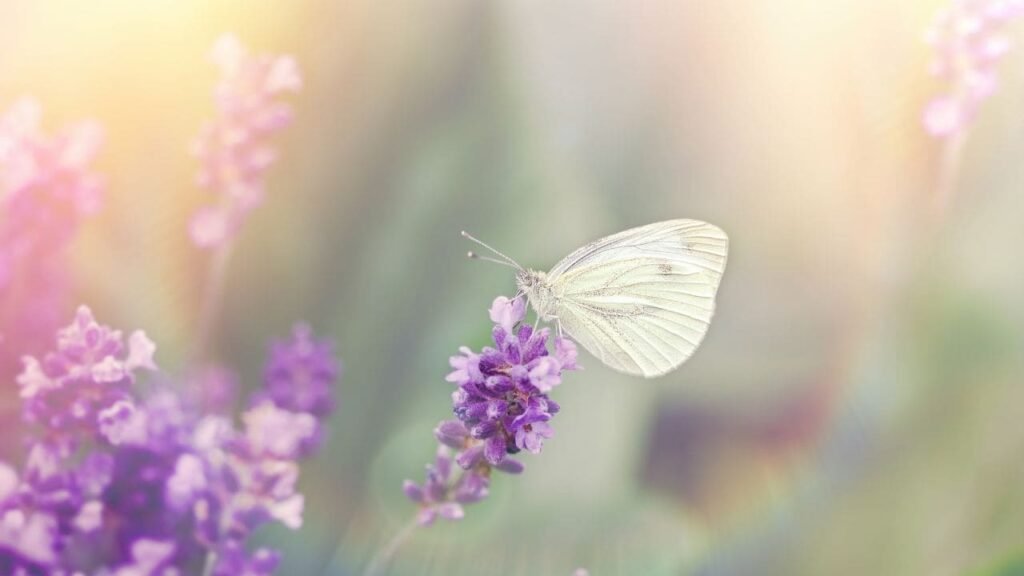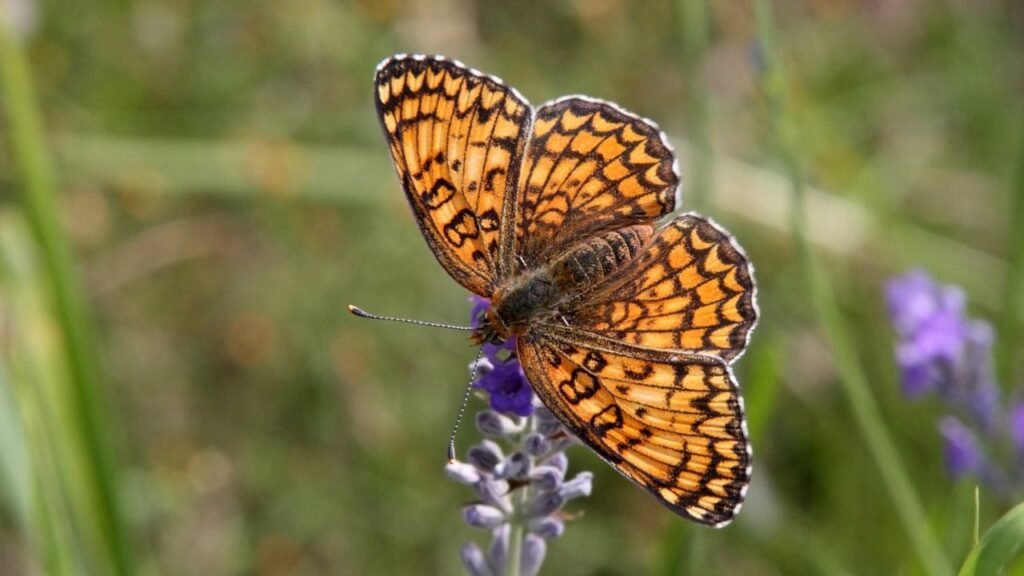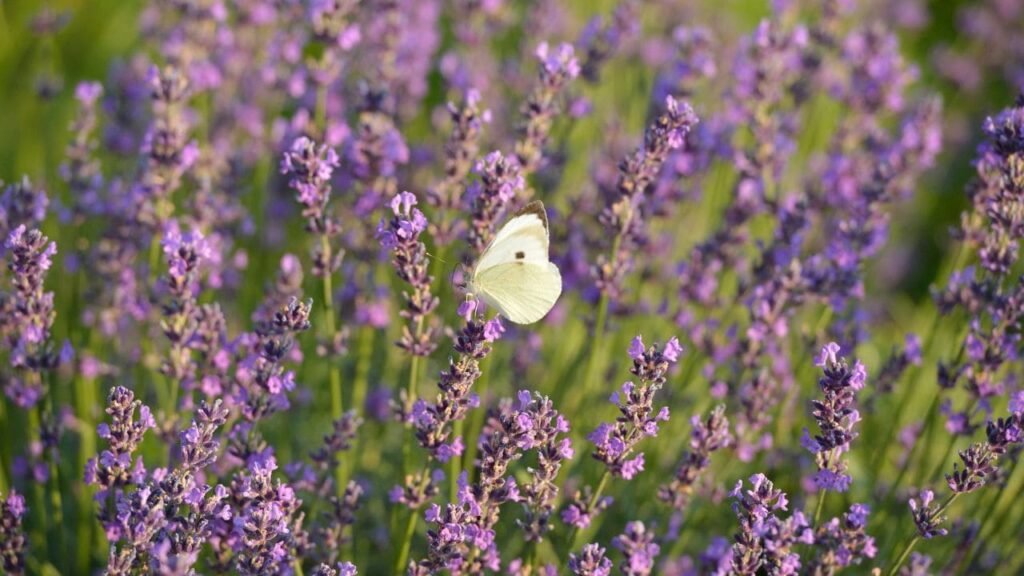


If you’ve wandered through a fragrant lavender field in midsummer, you’ve likely noticed the winged aerialists dancing from flower to Do Butterflies Like Lavender. With their brilliantly colored wings reflecting the sunlight, butterflies seem to delight in lavender just as much as we do. But what exactly attracts these shimmering beauties to drift toward these aromatic, purple blooms? As a longtime lavender lover and gardener, I decided to dig deeper into the connection between butterflies and lavender. What I unearthed surprised and delighted me!

Butterflies sip nectar from lavender blossoms through their long, slender proboscis like we would a sweet cocktail through a straw. They simply insert their proboscis into the tube-like structure at the base of the flower and sip up the delicious nectar within. Besides providing a tasty treat, another feature of lavender appeals to butterflies – its vibrant purple color. Butterflies have excellent color vision intended to help them locate nectar-rich flowers. So when they spot a swath of lavender blooms, they instantly recognize it as a prime feeding ground. Lavender also emits a lovely, sweet fragrance that helps attract butterflies from distances across the garden.
Butterflies need to feed frequently to maintain their high metabolisms and active lifestyles. By sipping sugary nectar from flowers, butterflies gain the carbohydrates they require as fuel for flight. Without ample nectar sources in the landscape, butterfly numbers would rapidly decline. Luckily, a hedge or plot of lavender can provide them an excellent source of nutrition.
Lavender attracts a wide array of gorgeous winged visitors across most regions. Some of the most commonly seen butterflies drifting through lavender include swallowtails, monarchs, painted ladies, fritillaries, sulphurs, skippers, mourning cloaks, admirals, cabbage whites, American ladies, and common buckeyes.
Painted lady butterflies especially thrive on lavender. In some years when native desert plants bloom profusely, painted lady populations explode and expand across North America. These orange-winged beauties swarm by the dozens on spikes of lavender, dancing delicately as they feed.
I’ve also noticed monarchs, cabbage whites, American ladies, red admirals and common buckeyes regularly visiting my lavender patches. The diversity and number of butterflies lavender appeals to is incredible! By planting different varieties that bloom in sequence, you can enjoy a continuous string of visitors all season long.
| Butterfly | Wingspan | Flight Period | Interesting Facts |
|---|---|---|---|
| Swallowtail | 3-6 inches | Spring to fall | Fans wings when feeding; citrus plant caterpillars |
| Monarch | 3-4 inches | Late summer/fall migration | Need milkweed plants; multi-generational migration |
| Painted Lady | 2-3 inches | Spring/summer (erratic) | Long distance travelers; thistle caterpillars |
| Fritillary | 2-4 inches | June-September | Often have silver-speckled undersides on hindwings |
| Sulphur | 1-2 inches | Spring-fall | Lemon yellow in color; enjoyed by gardeners |
| Skipper | 1 inch | Late spring-fall | Darting flight; hooked antennae; noisy wings |
If attracting more winged wonder to your garden sounds appealing, consider incorporating some lavender plants this coming spring. Lavender is quite easy to grow from nursery plants or cuttings. The optimal time for putting young lavender plants in the ground is early spring before butterfly season gets underway.
This gives the establishing plants a few months to grow roots before they need to support blooming. Aim to have your lavender plants well established to flower by mid summer when butterfly populations normally peak in most regions. Having nectar-rich blossoms awaiting them as they emerge provides essential energy.
Ideally, lavender prefers full sunlight and fast-draining soil. I mix small gravel and compost into my clay-heavy soil to improve drainage before planting lavender. Group shorter varieties like Munstead or Hidcote in drifts along borders or pathways where their scent can perfume the air. Space plants about 12-24 inches apart in holes the same depth as their containers. Lavender grown in abundance makes the biggest impact visually and offers more nectar incentive for fluttering visitors.
For a truly stunning sight, I love massing English lavender by walkways accompanied by bushy Russian sage nearby which also powerfully lures in butterflies. The contrasting colors and flower forms create compelling interest while offering butterflies options. You may also see bees, moths, hummingbirds and other pollinators enjoying them both!

One of the reasons I adore lavender is that – unlike more delicate blooms – it needs minimal fussing once properly established. Lavender plants naturally thrive in hot, dry conditions that would stress thirstier flowers. Just be sure not to overwater them. Soil drainage is key to prevent fungal root diseases from forming.
I trim my lavender plants back every spring by about a third before new growth emerges. This helps maintain a compact, shapely form and removes winter dieback. Pruning also encourages abundant blooming on the vigorous new shoots.
In cooler climates, apply a 4-6 inch thick insulating mulch around lavender plant bases in early fall. Pine straw or leaves locked in place by chicken wire work well. You can also grow potted lavender plants that can be brought into a sheltered location indoors over winter. With a little seasonal care, you’ll enjoy the beauty, fragrance and wildlife habitat of lavender for years!
While lavender is deservedly a butterfly favorite, consider intermingling other nectar-rich blooms nearby to provide diverse feeding opportunities. By including a sequence of plants that flower in spring, summer and fall, you can support a steady stream of visitors all season long.
Some excellent companion plants for lavender include gayfeather (liatris spicata), cosmos, oxeye daisies, coneflowers, wallflowers, vervain, sedum, asters, bee balm (monarda), zinnias, blazing star (Liatris spp), ironweed (Vernonia fasciculata), and butterfly weed (Asclepias tuberosa).
I like to edge my drifts of lavender with the bright purple spherical flowers of butterfly bush (buddleia davidii) which reliably brings in swallowtails, monarchs, sulphurs and red admirals by the dozen. The contrasting shapes and colors make a stunning display.
Herbs like thyme, oregano, parsley, fennel, dill, chives and even rosemary will also entice fluttering visitors. Allow some to flower for added appeal. Mixing in wild native plants like milkweed provides food sources for caterpillars as well.

As you relax outdoors this season, picture the fenceline filled with vibrant wings gently fluttering from flower to aromatic flower. By devoting garden space to drifts of lush lavender accented with diverse blooms, you’ll help sustain fragile butterfly populations while enjoying their spectacular show.
Not only will thoughtfully enhancing habitat for butterflies give you a front-row seat to nature’s aerial dance, you’ll gain the satisfaction of supporting conservation efforts for these beloved creatures. Keep your plantings free of pesticides, provide water in a soaked sand area, and leave wild corners of leaves and dry sticks for shelter.
Your efforts will be rewarded with their graceful flight and plenty of lavender bouquets with which to craft aromatic sachets and wreaths for your home. Discover the joy that do Butterflies Like Lavender can bring to your garden!
Do butterflies like all types of lavender plants?
Butterflies are typically most attracted to English lavender (Lavandula angustifolia) and Spanish lavender (Lavandula stoechas). These lavender species produce more nectar that butterflies can access easily with their proboscis compared to fringe-topped French lavender varieties. Compact English lavenders like Munstead and Hidcote are especially popular butterfly magnets!
What is the best way to plant lavender for butterflies?
Plant several groupings of at least 3-5 lavender plants spaced 1-2 feet apart in full sunlight areas with well-drained soil. Adding sand/gravel to heavy soils improves drainage. Plant in the spring several months before butterflies emerge so plants establish roots to support summer flowering. Choose compact English lavender cultivars for borders and walkways.
How do I get more butterflies to visit my garden?
Incorporate clusters of different nectar plants that have overlapping bloom times. Butterfly bush, Russian sage, bee balm, sedum, zinnias, cosmos, and other late spring through fall bloomers provide constant food sources. Have a mix of vivid flower colors since butterflies see in a wide spectrum. Include flat stones or sandy patches as butterfly “watering holes” for minerals.
When during the growing season should I see the most butterflies on lavender?
You are likely to see peak butterfly activity on blossoming lavender plants between mid-summer and early fall when populations are at their highest. However, in warmer climates where lavender blooms nearly year-round, butterflies will visit during any flowering flush following rains and cooler weather. Prolong blooms by promptly deadheading faded lavender flower spikes.
Should I use any special fertilizer for lavender plants?
Lavender thrives on low soil nutrients and is prone to getting “leggy” growth with excess nitrogen fertilization. Use 1/2 strength or less of a balanced organic vegetable food once monthly through spring and skip fertilizing entirely once flower buds form. Excess nutrients can diminish blooms and aromatic oils that attract pollinators like butterflies to lavender.